BUSN20017: Essay on Effective Business Communication Practices
VerifiedAdded on 2022/10/02
|7
|1994
|201
Essay
AI Summary
This essay examines the crucial role of competent communication in the business environment, specifically within an Australian context where an international agricultural products supplier is integrating ten new Chinese employees. It details verbal, written, and non-verbal communication methods, alongside discussions of assertive, passive, aggressive, and passive-aggressive communication styles. The essay emphasizes the importance of understanding cultural nuances to foster effective communication with expatriates. It suggests competent behaviors like informal get-togethers and respecting cultural differences, while cautioning against incompetent behaviors like mocking or comparing cultures. The objective is to guide employees in successfully communicating with expatriates, fostering a positive and productive workplace environment, and leveraging diverse perspectives to enhance business outcomes, supported by academic references from the last ten years.
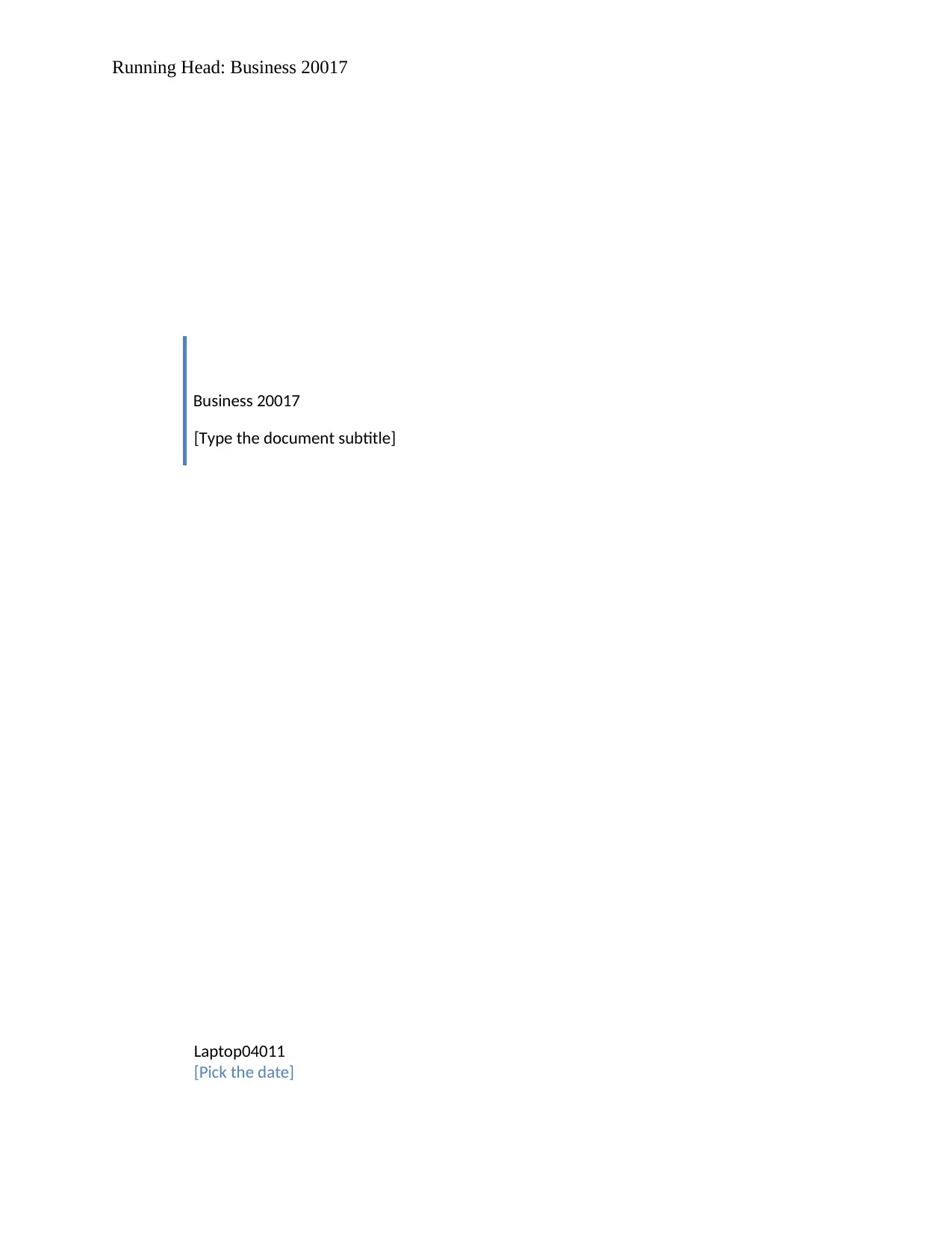
Running Head: Business 20017
Business 20017
[Type the document subtitle]
Laptop04011
[Pick the date]
Business 20017
[Type the document subtitle]
Laptop04011
[Pick the date]
Paraphrase This Document
Need a fresh take? Get an instant paraphrase of this document with our AI Paraphraser
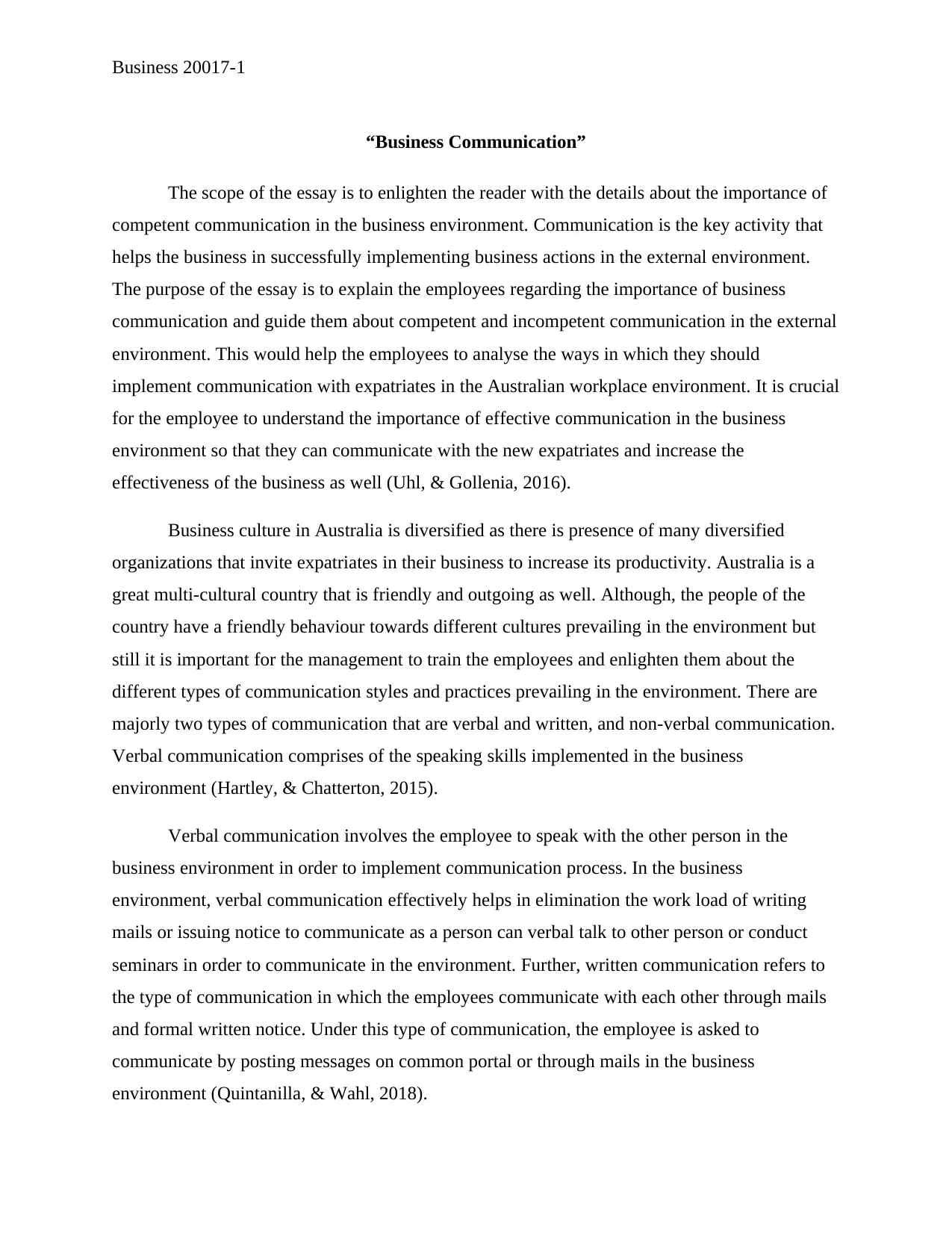
Business 20017-1
“Business Communication”
The scope of the essay is to enlighten the reader with the details about the importance of
competent communication in the business environment. Communication is the key activity that
helps the business in successfully implementing business actions in the external environment.
The purpose of the essay is to explain the employees regarding the importance of business
communication and guide them about competent and incompetent communication in the external
environment. This would help the employees to analyse the ways in which they should
implement communication with expatriates in the Australian workplace environment. It is crucial
for the employee to understand the importance of effective communication in the business
environment so that they can communicate with the new expatriates and increase the
effectiveness of the business as well (Uhl, & Gollenia, 2016).
Business culture in Australia is diversified as there is presence of many diversified
organizations that invite expatriates in their business to increase its productivity. Australia is a
great multi-cultural country that is friendly and outgoing as well. Although, the people of the
country have a friendly behaviour towards different cultures prevailing in the environment but
still it is important for the management to train the employees and enlighten them about the
different types of communication styles and practices prevailing in the environment. There are
majorly two types of communication that are verbal and written, and non-verbal communication.
Verbal communication comprises of the speaking skills implemented in the business
environment (Hartley, & Chatterton, 2015).
Verbal communication involves the employee to speak with the other person in the
business environment in order to implement communication process. In the business
environment, verbal communication effectively helps in elimination the work load of writing
mails or issuing notice to communicate as a person can verbal talk to other person or conduct
seminars in order to communicate in the environment. Further, written communication refers to
the type of communication in which the employees communicate with each other through mails
and formal written notice. Under this type of communication, the employee is asked to
communicate by posting messages on common portal or through mails in the business
environment (Quintanilla, & Wahl, 2018).
“Business Communication”
The scope of the essay is to enlighten the reader with the details about the importance of
competent communication in the business environment. Communication is the key activity that
helps the business in successfully implementing business actions in the external environment.
The purpose of the essay is to explain the employees regarding the importance of business
communication and guide them about competent and incompetent communication in the external
environment. This would help the employees to analyse the ways in which they should
implement communication with expatriates in the Australian workplace environment. It is crucial
for the employee to understand the importance of effective communication in the business
environment so that they can communicate with the new expatriates and increase the
effectiveness of the business as well (Uhl, & Gollenia, 2016).
Business culture in Australia is diversified as there is presence of many diversified
organizations that invite expatriates in their business to increase its productivity. Australia is a
great multi-cultural country that is friendly and outgoing as well. Although, the people of the
country have a friendly behaviour towards different cultures prevailing in the environment but
still it is important for the management to train the employees and enlighten them about the
different types of communication styles and practices prevailing in the environment. There are
majorly two types of communication that are verbal and written, and non-verbal communication.
Verbal communication comprises of the speaking skills implemented in the business
environment (Hartley, & Chatterton, 2015).
Verbal communication involves the employee to speak with the other person in the
business environment in order to implement communication process. In the business
environment, verbal communication effectively helps in elimination the work load of writing
mails or issuing notice to communicate as a person can verbal talk to other person or conduct
seminars in order to communicate in the environment. Further, written communication refers to
the type of communication in which the employees communicate with each other through mails
and formal written notice. Under this type of communication, the employee is asked to
communicate by posting messages on common portal or through mails in the business
environment (Quintanilla, & Wahl, 2018).
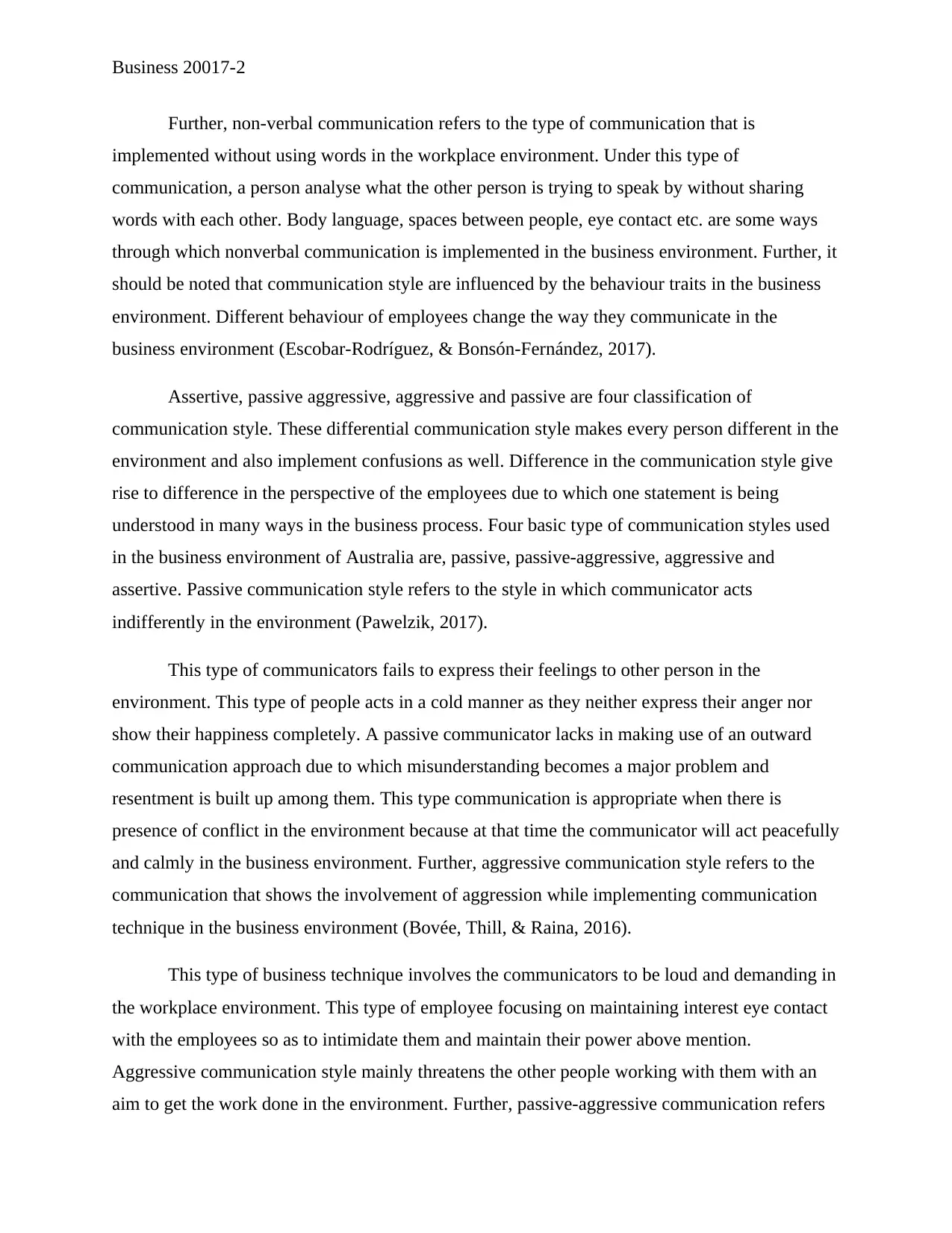
Business 20017-2
Further, non-verbal communication refers to the type of communication that is
implemented without using words in the workplace environment. Under this type of
communication, a person analyse what the other person is trying to speak by without sharing
words with each other. Body language, spaces between people, eye contact etc. are some ways
through which nonverbal communication is implemented in the business environment. Further, it
should be noted that communication style are influenced by the behaviour traits in the business
environment. Different behaviour of employees change the way they communicate in the
business environment (Escobar-Rodríguez, & Bonsón-Fernández, 2017).
Assertive, passive aggressive, aggressive and passive are four classification of
communication style. These differential communication style makes every person different in the
environment and also implement confusions as well. Difference in the communication style give
rise to difference in the perspective of the employees due to which one statement is being
understood in many ways in the business process. Four basic type of communication styles used
in the business environment of Australia are, passive, passive-aggressive, aggressive and
assertive. Passive communication style refers to the style in which communicator acts
indifferently in the environment (Pawelzik, 2017).
This type of communicators fails to express their feelings to other person in the
environment. This type of people acts in a cold manner as they neither express their anger nor
show their happiness completely. A passive communicator lacks in making use of an outward
communication approach due to which misunderstanding becomes a major problem and
resentment is built up among them. This type communication is appropriate when there is
presence of conflict in the environment because at that time the communicator will act peacefully
and calmly in the business environment. Further, aggressive communication style refers to the
communication that shows the involvement of aggression while implementing communication
technique in the business environment (Bovée, Thill, & Raina, 2016).
This type of business technique involves the communicators to be loud and demanding in
the workplace environment. This type of employee focusing on maintaining interest eye contact
with the employees so as to intimidate them and maintain their power above mention.
Aggressive communication style mainly threatens the other people working with them with an
aim to get the work done in the environment. Further, passive-aggressive communication refers
Further, non-verbal communication refers to the type of communication that is
implemented without using words in the workplace environment. Under this type of
communication, a person analyse what the other person is trying to speak by without sharing
words with each other. Body language, spaces between people, eye contact etc. are some ways
through which nonverbal communication is implemented in the business environment. Further, it
should be noted that communication style are influenced by the behaviour traits in the business
environment. Different behaviour of employees change the way they communicate in the
business environment (Escobar-Rodríguez, & Bonsón-Fernández, 2017).
Assertive, passive aggressive, aggressive and passive are four classification of
communication style. These differential communication style makes every person different in the
environment and also implement confusions as well. Difference in the communication style give
rise to difference in the perspective of the employees due to which one statement is being
understood in many ways in the business process. Four basic type of communication styles used
in the business environment of Australia are, passive, passive-aggressive, aggressive and
assertive. Passive communication style refers to the style in which communicator acts
indifferently in the environment (Pawelzik, 2017).
This type of communicators fails to express their feelings to other person in the
environment. This type of people acts in a cold manner as they neither express their anger nor
show their happiness completely. A passive communicator lacks in making use of an outward
communication approach due to which misunderstanding becomes a major problem and
resentment is built up among them. This type communication is appropriate when there is
presence of conflict in the environment because at that time the communicator will act peacefully
and calmly in the business environment. Further, aggressive communication style refers to the
communication that shows the involvement of aggression while implementing communication
technique in the business environment (Bovée, Thill, & Raina, 2016).
This type of business technique involves the communicators to be loud and demanding in
the workplace environment. This type of employee focusing on maintaining interest eye contact
with the employees so as to intimidate them and maintain their power above mention.
Aggressive communication style mainly threatens the other people working with them with an
aim to get the work done in the environment. Further, passive-aggressive communication refers
⊘ This is a preview!⊘
Do you want full access?
Subscribe today to unlock all pages.

Trusted by 1+ million students worldwide
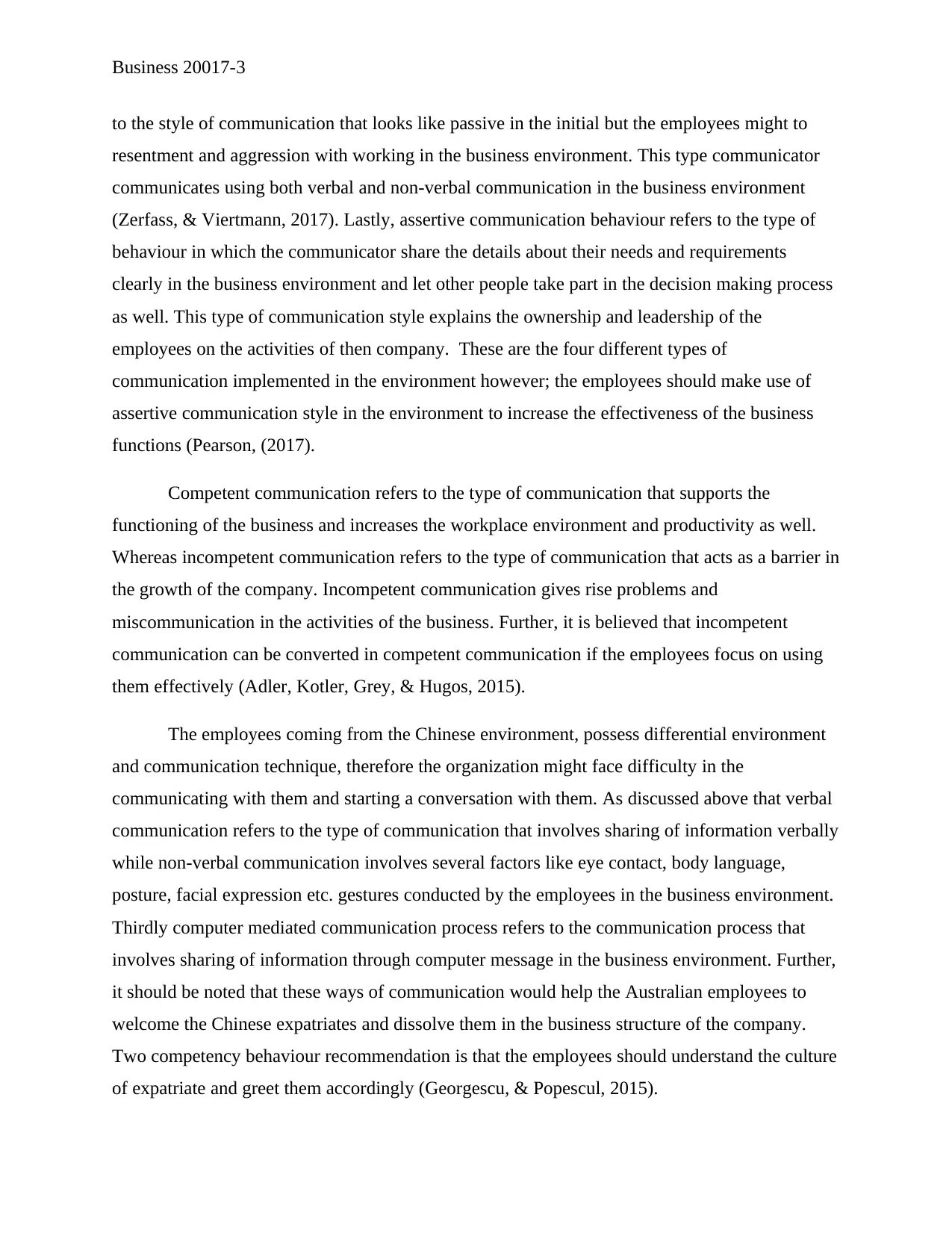
Business 20017-3
to the style of communication that looks like passive in the initial but the employees might to
resentment and aggression with working in the business environment. This type communicator
communicates using both verbal and non-verbal communication in the business environment
(Zerfass, & Viertmann, 2017). Lastly, assertive communication behaviour refers to the type of
behaviour in which the communicator share the details about their needs and requirements
clearly in the business environment and let other people take part in the decision making process
as well. This type of communication style explains the ownership and leadership of the
employees on the activities of then company. These are the four different types of
communication implemented in the environment however; the employees should make use of
assertive communication style in the environment to increase the effectiveness of the business
functions (Pearson, (2017).
Competent communication refers to the type of communication that supports the
functioning of the business and increases the workplace environment and productivity as well.
Whereas incompetent communication refers to the type of communication that acts as a barrier in
the growth of the company. Incompetent communication gives rise problems and
miscommunication in the activities of the business. Further, it is believed that incompetent
communication can be converted in competent communication if the employees focus on using
them effectively (Adler, Kotler, Grey, & Hugos, 2015).
The employees coming from the Chinese environment, possess differential environment
and communication technique, therefore the organization might face difficulty in the
communicating with them and starting a conversation with them. As discussed above that verbal
communication refers to the type of communication that involves sharing of information verbally
while non-verbal communication involves several factors like eye contact, body language,
posture, facial expression etc. gestures conducted by the employees in the business environment.
Thirdly computer mediated communication process refers to the communication process that
involves sharing of information through computer message in the business environment. Further,
it should be noted that these ways of communication would help the Australian employees to
welcome the Chinese expatriates and dissolve them in the business structure of the company.
Two competency behaviour recommendation is that the employees should understand the culture
of expatriate and greet them accordingly (Georgescu, & Popescul, 2015).
to the style of communication that looks like passive in the initial but the employees might to
resentment and aggression with working in the business environment. This type communicator
communicates using both verbal and non-verbal communication in the business environment
(Zerfass, & Viertmann, 2017). Lastly, assertive communication behaviour refers to the type of
behaviour in which the communicator share the details about their needs and requirements
clearly in the business environment and let other people take part in the decision making process
as well. This type of communication style explains the ownership and leadership of the
employees on the activities of then company. These are the four different types of
communication implemented in the environment however; the employees should make use of
assertive communication style in the environment to increase the effectiveness of the business
functions (Pearson, (2017).
Competent communication refers to the type of communication that supports the
functioning of the business and increases the workplace environment and productivity as well.
Whereas incompetent communication refers to the type of communication that acts as a barrier in
the growth of the company. Incompetent communication gives rise problems and
miscommunication in the activities of the business. Further, it is believed that incompetent
communication can be converted in competent communication if the employees focus on using
them effectively (Adler, Kotler, Grey, & Hugos, 2015).
The employees coming from the Chinese environment, possess differential environment
and communication technique, therefore the organization might face difficulty in the
communicating with them and starting a conversation with them. As discussed above that verbal
communication refers to the type of communication that involves sharing of information verbally
while non-verbal communication involves several factors like eye contact, body language,
posture, facial expression etc. gestures conducted by the employees in the business environment.
Thirdly computer mediated communication process refers to the communication process that
involves sharing of information through computer message in the business environment. Further,
it should be noted that these ways of communication would help the Australian employees to
welcome the Chinese expatriates and dissolve them in the business structure of the company.
Two competency behaviour recommendation is that the employees should understand the culture
of expatriate and greet them accordingly (Georgescu, & Popescul, 2015).
Paraphrase This Document
Need a fresh take? Get an instant paraphrase of this document with our AI Paraphraser
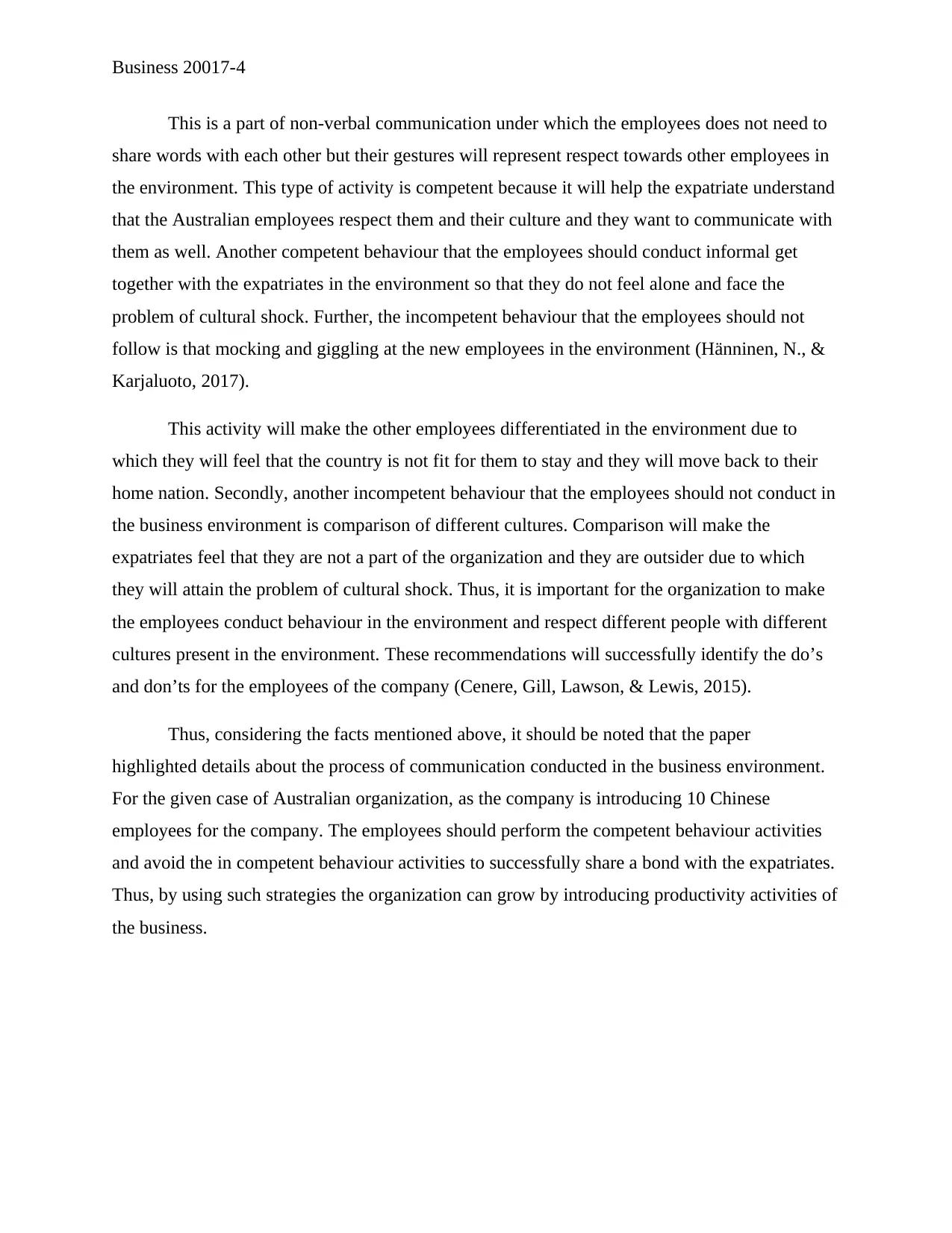
Business 20017-4
This is a part of non-verbal communication under which the employees does not need to
share words with each other but their gestures will represent respect towards other employees in
the environment. This type of activity is competent because it will help the expatriate understand
that the Australian employees respect them and their culture and they want to communicate with
them as well. Another competent behaviour that the employees should conduct informal get
together with the expatriates in the environment so that they do not feel alone and face the
problem of cultural shock. Further, the incompetent behaviour that the employees should not
follow is that mocking and giggling at the new employees in the environment (Hänninen, N., &
Karjaluoto, 2017).
This activity will make the other employees differentiated in the environment due to
which they will feel that the country is not fit for them to stay and they will move back to their
home nation. Secondly, another incompetent behaviour that the employees should not conduct in
the business environment is comparison of different cultures. Comparison will make the
expatriates feel that they are not a part of the organization and they are outsider due to which
they will attain the problem of cultural shock. Thus, it is important for the organization to make
the employees conduct behaviour in the environment and respect different people with different
cultures present in the environment. These recommendations will successfully identify the do’s
and don’ts for the employees of the company (Cenere, Gill, Lawson, & Lewis, 2015).
Thus, considering the facts mentioned above, it should be noted that the paper
highlighted details about the process of communication conducted in the business environment.
For the given case of Australian organization, as the company is introducing 10 Chinese
employees for the company. The employees should perform the competent behaviour activities
and avoid the in competent behaviour activities to successfully share a bond with the expatriates.
Thus, by using such strategies the organization can grow by introducing productivity activities of
the business.
This is a part of non-verbal communication under which the employees does not need to
share words with each other but their gestures will represent respect towards other employees in
the environment. This type of activity is competent because it will help the expatriate understand
that the Australian employees respect them and their culture and they want to communicate with
them as well. Another competent behaviour that the employees should conduct informal get
together with the expatriates in the environment so that they do not feel alone and face the
problem of cultural shock. Further, the incompetent behaviour that the employees should not
follow is that mocking and giggling at the new employees in the environment (Hänninen, N., &
Karjaluoto, 2017).
This activity will make the other employees differentiated in the environment due to
which they will feel that the country is not fit for them to stay and they will move back to their
home nation. Secondly, another incompetent behaviour that the employees should not conduct in
the business environment is comparison of different cultures. Comparison will make the
expatriates feel that they are not a part of the organization and they are outsider due to which
they will attain the problem of cultural shock. Thus, it is important for the organization to make
the employees conduct behaviour in the environment and respect different people with different
cultures present in the environment. These recommendations will successfully identify the do’s
and don’ts for the employees of the company (Cenere, Gill, Lawson, & Lewis, 2015).
Thus, considering the facts mentioned above, it should be noted that the paper
highlighted details about the process of communication conducted in the business environment.
For the given case of Australian organization, as the company is introducing 10 Chinese
employees for the company. The employees should perform the competent behaviour activities
and avoid the in competent behaviour activities to successfully share a bond with the expatriates.
Thus, by using such strategies the organization can grow by introducing productivity activities of
the business.
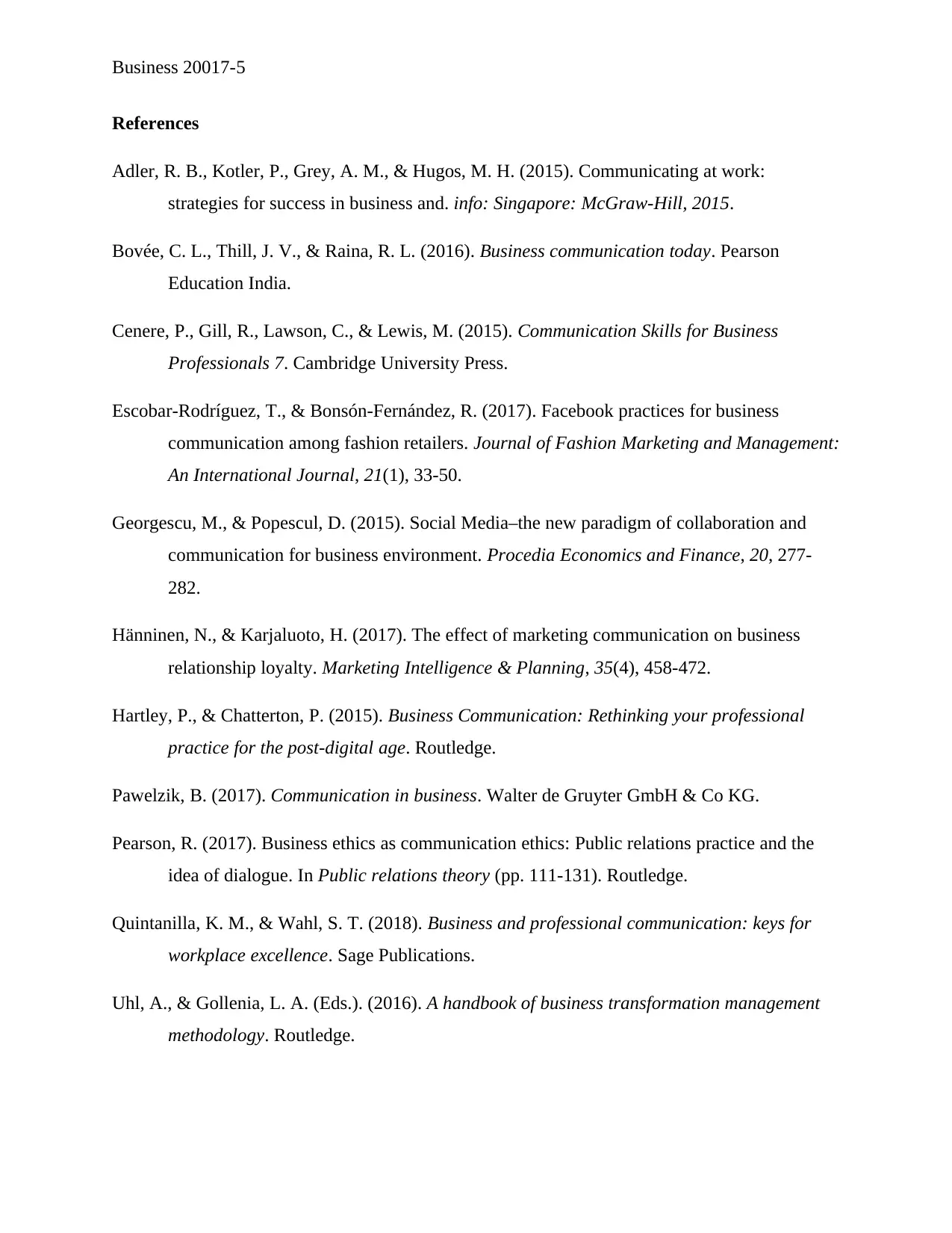
Business 20017-5
References
Adler, R. B., Kotler, P., Grey, A. M., & Hugos, M. H. (2015). Communicating at work:
strategies for success in business and. info: Singapore: McGraw-Hill, 2015.
Bovée, C. L., Thill, J. V., & Raina, R. L. (2016). Business communication today. Pearson
Education India.
Cenere, P., Gill, R., Lawson, C., & Lewis, M. (2015). Communication Skills for Business
Professionals 7. Cambridge University Press.
Escobar-Rodríguez, T., & Bonsón-Fernández, R. (2017). Facebook practices for business
communication among fashion retailers. Journal of Fashion Marketing and Management:
An International Journal, 21(1), 33-50.
Georgescu, M., & Popescul, D. (2015). Social Media–the new paradigm of collaboration and
communication for business environment. Procedia Economics and Finance, 20, 277-
282.
Hänninen, N., & Karjaluoto, H. (2017). The effect of marketing communication on business
relationship loyalty. Marketing Intelligence & Planning, 35(4), 458-472.
Hartley, P., & Chatterton, P. (2015). Business Communication: Rethinking your professional
practice for the post-digital age. Routledge.
Pawelzik, B. (2017). Communication in business. Walter de Gruyter GmbH & Co KG.
Pearson, R. (2017). Business ethics as communication ethics: Public relations practice and the
idea of dialogue. In Public relations theory (pp. 111-131). Routledge.
Quintanilla, K. M., & Wahl, S. T. (2018). Business and professional communication: keys for
workplace excellence. Sage Publications.
Uhl, A., & Gollenia, L. A. (Eds.). (2016). A handbook of business transformation management
methodology. Routledge.
References
Adler, R. B., Kotler, P., Grey, A. M., & Hugos, M. H. (2015). Communicating at work:
strategies for success in business and. info: Singapore: McGraw-Hill, 2015.
Bovée, C. L., Thill, J. V., & Raina, R. L. (2016). Business communication today. Pearson
Education India.
Cenere, P., Gill, R., Lawson, C., & Lewis, M. (2015). Communication Skills for Business
Professionals 7. Cambridge University Press.
Escobar-Rodríguez, T., & Bonsón-Fernández, R. (2017). Facebook practices for business
communication among fashion retailers. Journal of Fashion Marketing and Management:
An International Journal, 21(1), 33-50.
Georgescu, M., & Popescul, D. (2015). Social Media–the new paradigm of collaboration and
communication for business environment. Procedia Economics and Finance, 20, 277-
282.
Hänninen, N., & Karjaluoto, H. (2017). The effect of marketing communication on business
relationship loyalty. Marketing Intelligence & Planning, 35(4), 458-472.
Hartley, P., & Chatterton, P. (2015). Business Communication: Rethinking your professional
practice for the post-digital age. Routledge.
Pawelzik, B. (2017). Communication in business. Walter de Gruyter GmbH & Co KG.
Pearson, R. (2017). Business ethics as communication ethics: Public relations practice and the
idea of dialogue. In Public relations theory (pp. 111-131). Routledge.
Quintanilla, K. M., & Wahl, S. T. (2018). Business and professional communication: keys for
workplace excellence. Sage Publications.
Uhl, A., & Gollenia, L. A. (Eds.). (2016). A handbook of business transformation management
methodology. Routledge.
⊘ This is a preview!⊘
Do you want full access?
Subscribe today to unlock all pages.

Trusted by 1+ million students worldwide
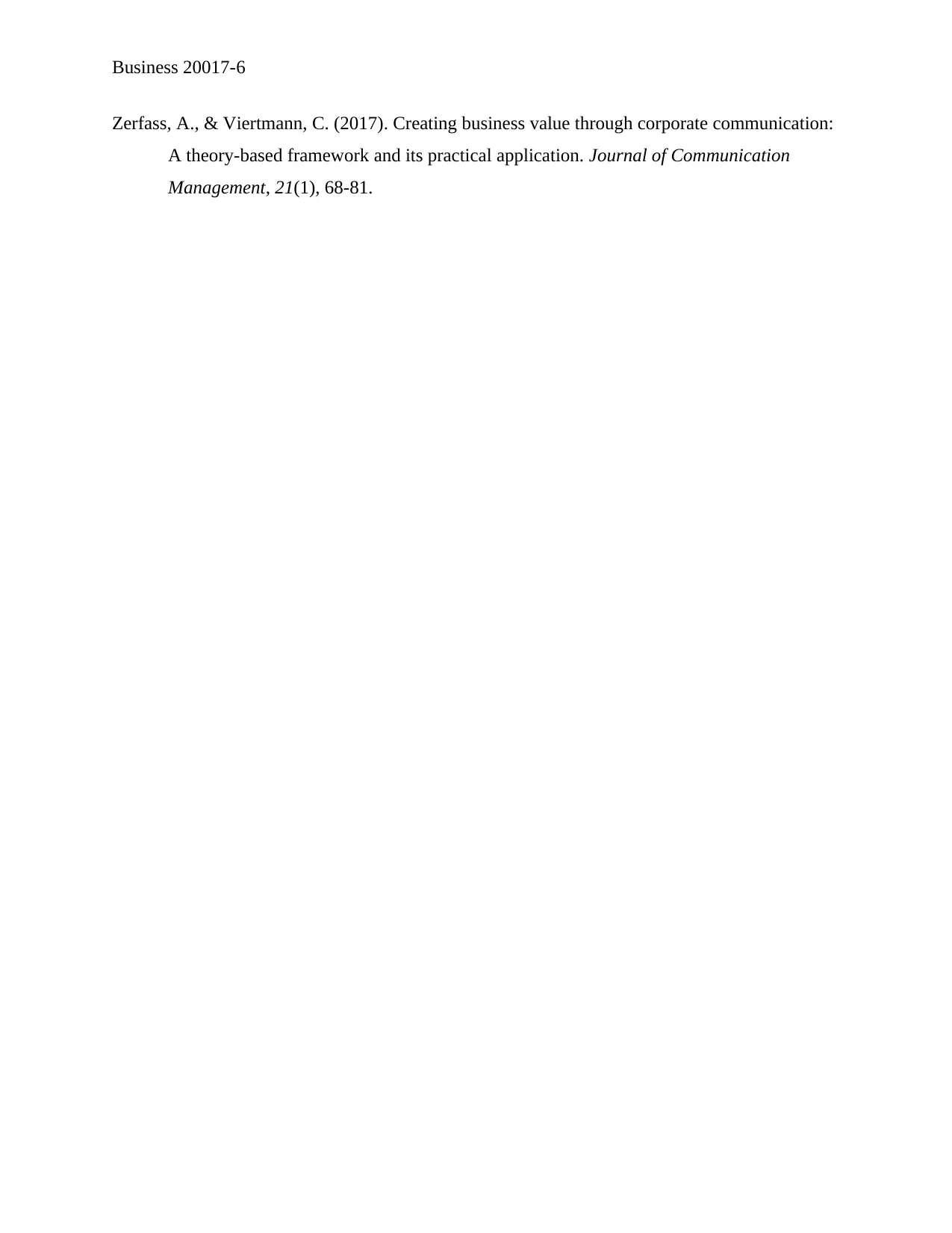
Business 20017-6
Zerfass, A., & Viertmann, C. (2017). Creating business value through corporate communication:
A theory-based framework and its practical application. Journal of Communication
Management, 21(1), 68-81.
Zerfass, A., & Viertmann, C. (2017). Creating business value through corporate communication:
A theory-based framework and its practical application. Journal of Communication
Management, 21(1), 68-81.
1 out of 7
Related Documents
Your All-in-One AI-Powered Toolkit for Academic Success.
+13062052269
info@desklib.com
Available 24*7 on WhatsApp / Email
![[object Object]](/_next/static/media/star-bottom.7253800d.svg)
Unlock your academic potential
Copyright © 2020–2025 A2Z Services. All Rights Reserved. Developed and managed by ZUCOL.




